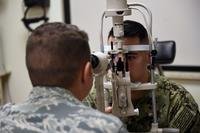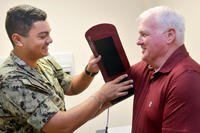 Military Update: Wounded Warrior Project
Military Update: Wounded Warrior Project
Americans must be increasingly curious about Wounded Warrior Project with its ubiquitous TV appeals for donations to help veterans of our longest wars, in Iraq and Afghanistan, recover and transition to civilian life.
Operation Iraqi Freedom, after all, ended three years ago. U.S. forces in Afghanistan no longer engage routinely in combat. The Department of Defense lists just under 52,000 wounded in the two wars, including through March 2 for Afghanistan. The Department of Veterans Affairs says its own spending on disability compensation, health care, rehabilitation, vocational training and caregiver support is up 73 percent just since 2009.
So why do Wounded Warrior Project (WWP) ads still populate our prime time hours and appear in our mailboxes and favorite websites?
Steven Nardizzi, chief executive officer of WWP, said it’s because the Project is busier than ever filling gaps in education, counseling and other activities needed to “honor and empower” warriors of recent wars. The goal is to make Iraq and Afghanistan veterans “the most successful and well-adjusted generation of wounded service members in our nation’s history.”
DoD data on wounded don’t include many thousands of vets with post-traumatic stress or mild to moderate traumatic brain injury, he said. The mentally wounded are now 78 percent of warriors using WWP services, and yet represent only a fraction of what the total could be, Nardizzi added.
So far, America is onboard.
WWP didn’t exist a dozen years ago. Then a few concerned vets and friends began giving returning wounded backpacks of socks, toiletries and other items to make hospital stays more comfortable. Today WWP has annual revenues of $325 million, 500 employees and a spectrum of programs to help warriors heal body and mind, secure jobs and engage in society.
WWP assets jumped $56 million in fiscal 2013 alone to more than $166 million. Its fundraising is more than double that of the USO, and is a juggernaut alongside many other veteran charities. Its program spending of $117 million in 2013 included $16.8 million in grants to other charities, including a $250,000 donation to American Red Cross to help wounded warriors impacted by Hurricane Sandy.
Its most successful fundraising tool is TV ads with wounded warriors and spouses, mellow music and celebrity spokesmen. WWP also raises millions through direct mail solicitations and online advertising.
“Our fundraising has been growing at a compound annual growth rate of between 40 and 50 percent, year over year, every year, and through the recession as well by the way,” Nardizzi said. “So I would agree with you we’re incredibly sound in fundraising. But if you go back over the same period [and look at] program spending, it’s grown by the same rate, a compound annual growth rate of 40 to 50 percent.”
WWP is “fundraising to plan,” he said, “not raising money for the sake of raising money. We raise money to do our programs and make an impact.”
To date, 67,000 wounded have used at least one WWP service or benefit. The goal is 100,000 “alumni” by 2017 and its on pace to reach it.
In a lengthy phone interview, Nardizzi reviewed the breadth of WWP services, which are exclusive to the generation who served after 9/11. He said most veteran service organizations are fraternal and lobby for laws or policy changes while helping vets gain access to VA benefits. WWP counts itself among newer charities that offer human services to warriors so they don’t feel isolated and shoved aside or a loss of dignity during their recovery.
“Could the government put clothing and comfort items at the bedside of every wounded warrior? I absolutely think [it] could,” Nardizzi said. “Does that send the same signal to somebody’s who’s struggling, that your community is here for you, the American public hasn’t forgotten you and we’re supporting your recovery? No I don’t [think it] would.”
VA provides compensation, health care and safety net programs “on a scale we never could,” he added. “But there are many other aspects of recovery where having the American public engaged is helpful to warriors and [results in] better delivery of service.”
WWP programs fall into four categories. Engagement programs help 28,600 warriors interact with communities and other vets; cognitive health courses help 4260 warriors recover from post-traumatic stress or mild traumatic brain; physical health programs provide 8800 warriors with wellness and nutrition counseling and adaptive sporting events; 8700 warriors take WWP courses or receive skill training toward finding work, with a special emphasis on career paths in computers and information technology.
One of its most costly offerings is Track, a college preparatory program at a local college in San Antonio and another in Jacksonville, Fla. WWP pays for tutoring and rehabilitative services as 120 wounded warriors annually work toward degrees or vocational certificates. It covers their moving expenses, subsidizes their housing, ensures a regimen of daily exercise and pays a living stipend. This is atop GI Bill benefits or VA vocational services, “which they would use but not to pay us,” Nardizzi said. “They pay the college for credits and we provide all the other support.”
An Independence Program, he said, keeps 250 warriors with moderate to severe brain injury, spinal-cord injury or severe neurological conditions out of state nursing homes by ensuring that their family caregivers and support teams have all the resources needed to care for them at home.
Nardizzi said he welcomed a question on his WWP compensation which IRS forms show was almost $400,000 in 2013, with 10 other WWP executives receiving at least $150,000. The WWP board of directors, he said, sets his salary based on CEO compensation at like-size charities.
“We’re trying to solve the world’s ills here…We’re not putting a car out to market [but] providing comprehensive services to help wounded warriors [to] move forward. And you don’t do that on a shoestring budget or with less than professional services, not if you want to do it right. So we pay people a competitive salary in the profession their in.”
Nardizzi was asked what would happen to WWP if many years pass and there are no more wounded warriors.
“God willing we’ll get to that place where we don’t have wounded warriors in need…Our organization would thankfully start shuttering its doors and get to a point where perhaps a much smaller organization is just ready…to spin the programs back up if they are ever needed again.
“Do I think in five or ten years that’s likely to happen? Not based on the population I’m seeing and working with and the many we haven’t reached…It's been a long decade or more, and we’ve seen a lot of folks struggling. The good news is we have a lot of folks doing really well too, coming out the other side of it.”
To comment, write Military Update, P.O. Box 231111, Centreville, VA, or email milupdate@aol.com or twitter: Tom Philpott @Military_Update
# # # #
Tom Philpott has been breaking news for and about military people since 1977. After service in the Coast Guard, and 17 years as a reporter and senior editor with Army Times Publishing Company, Tom launched "Military Update," his syndicated weekly news column, in 1994. "Military Update" features timely news and analysis on issues affecting active duty members, reservists, retirees and their families.
Visit Tom Philpott's Military Update Archive to view his past articles.
Tom also edits a reader reaction column, "Military Forum." The online "home" for both features is Military.com.
 Tom's freelance articles have appeared in numerous magazines including The New Yorker, Reader's Digest and Washingtonian.
Tom's freelance articles have appeared in numerous magazines including The New Yorker, Reader's Digest and Washingtonian.
His critically-acclaimed book, Glory Denied, on the extraordinary ordeal and heroism of Col. Floyd "Jim" Thompson, the longest-held prisoner of war in American history, is available in hardcover and paperback.



